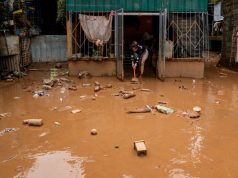
The three most powerful tropical cyclones that stepped on land entered the Philippines, records show.
Jeff Masters, a meteorologist who founded a weather monitoring website called Weather Underground, named the typhoons Goni (local name Rolly), Meranti (Ferdie) and Haiyan (Yolanda) as the strongest cyclones in terms of wind speed at landfall recorded in history.
“With 195 mph winds, Goni is the strongest landfalling tropical cyclone in world recorded history. Previous record: Super Typhoon Meranti, September 16, 2016, Itbayat Island, Philippines, and Super Typhoon Haiyan, November 8, 2013, Leyte Island, Philippines (190 mph winds),” he tweeted on November 1.
With 195 mph winds, Goni is the strongest landfalling tropical cyclone in world recorded history. Previous record: Super Typhoon Meranti, September 16, 2016, Itbayat Island, Philippines, and Super Typhoon Haiyan, November 8, 2013, Leyte Island, Philippines (190 mph winds). pic.twitter.com/aNAJOgL5q9
— Jeff Masters (@DrJeffMasters) October 31, 2020
In one of the quoted retweets, an environment technician named Daniel Kieve described the situation as “unfair” to the Philippines, citing that the country has fewer carbon emissions than the United States and the European Union.
“Not fair…The 3 most powerful storm landfalls in recorded history have all occurred in the #Philippines, a country with one of the lowest per capita emissions (20 times less than EU and 30 times less than US). All 3 cyclones have occurred in the last 8 years fueled by warming oceans,” Kieve wrote.
Other users, meanwhile, noted that the Philippine government should have been better prepared by now.
“The Philippines is a hotspot for the world’s strongest typhoons but why aren’t we still prepared if we’ve already been struck the third time now?” one user said.
“Strongest in recorded history. Let that sink in. Then, think about the government’s response (if any), the media blackouts, and everything else. Whether it’s incompetence, greed, or whatever, people have died,” another user said.
Strongest at landfall
In an article published on Yale Climate Connections, an analytical radio program on climate change, Masters cited the National Hurricane Center and the Joint Typhoon Warning Center (JTWC) as sources for this information.
The top 10 strongest tropical cyclones in miles per hour (mph) at first landfall in world history are:
- 195 mph: Super Typhoon Goni, 2020—Catanduanes, Philippines
- 190 mph: Super Typhoon Haiyan, 2013—Leyte, Philippines
- 190 mph: Super Typhoon Meranti, 2016—Itbayat, Philippines
- 185 mph: Great Labor Day Hurricane, 1935—Florida, U.S.
- 185 mph: Super Typhoon Joan, 1959—Eastern Taiwan
- 180 mph: Hurricane Irma, 2017—Leeward Islands
- 180 mph: Cyclone Winston, 2016—Fiji
- 180 mph: Super Typhoon Megi, 2010—Luzon, Philippines
- 180 mph: Super Typhoon Zeb, 1998—Luzon, Philippines
- 180 mph: Cyclone Monica, 2006—Northern Territory, Australia
Masters noted in the report that “Rolly,” “Haiyan” and “Meranti” will still be among the strongest typhoons in world history in terms of maximum sustained winds.
Hurricane Patricia, which made landfall in Mexico in 2015, topped the list with maximum sustained winds of 215 mph.
Masters also stated the lack of proper equipment in measuring the intensities of “Rolly,” “Haiyan” and “Meranti” as compared to other storms.
“The winds of Goni, Haiyan, and Meranti were estimated using only satellite images, therefore providing less confidence in their intensity estimates. Satellite methods of estimating intensity, such as the Dvorak technique, cannot capture the most extreme peak winds and central pressures found in storms such as Patricia and Goni,” he said.
What about Ondoy and Ulysses?
How about other prominent typhoons such as Ondoy that triggered massive flooding across the country?
An article from the National Aeronautics and Space Administration explained that “Ondoy” (international name: Ketsana) was only a tropical depression when it landed in the country in 2009.
Despite its relative weakness, Ondoy dumped 455 millimeters of rain within 24 hours and eventually triggering deadly floods and landslides in Manila.
Typhoon Ulysses (international name Vamco), which also inundated many parts of Luzon, dropped 150 millimeters of rain within 24 hours.
As of November 17, reports stated that “Ulysses” left 73 deaths and over P8 billion in damages in its wake.
EFFECTS OF TYPHOON ULYSSES
(As of 9:00 AM, November 17, 2020)Umabot na sa 73 ang naitalang nasawi dahil sa pananalasa ng Typhoon #UlyssesPH (#Vamco). Umakyat naman sa halos PhP 8 Bilyon ang pinsala. Inaasahang aakyat pa ito habang pumapasok ang mga iba pang ulat. pic.twitter.com/wH8lKkEhoH
— Earth Shaker PH (@earthshakerph) November 17, 2020









